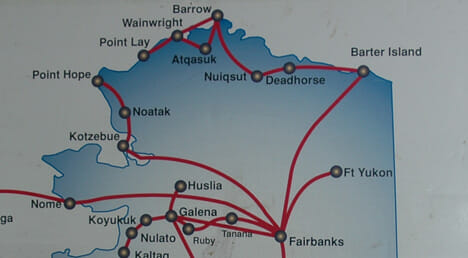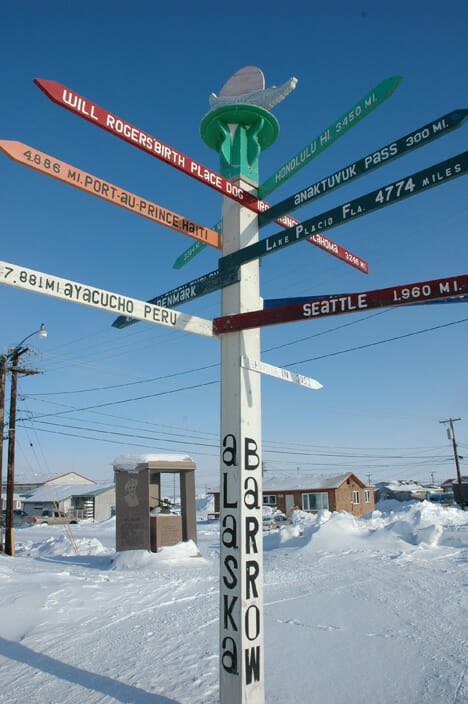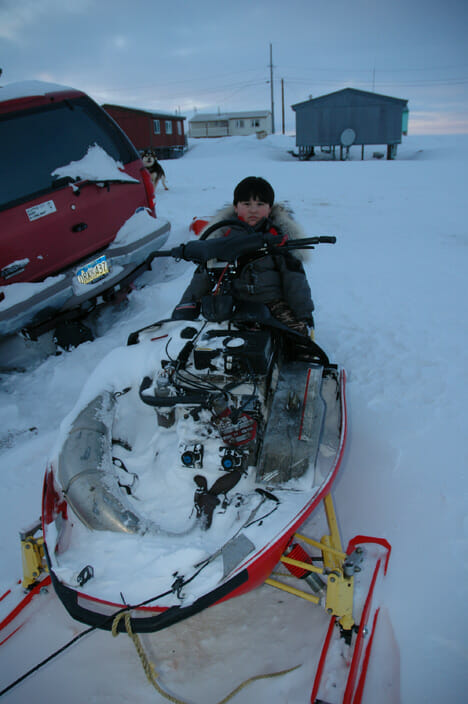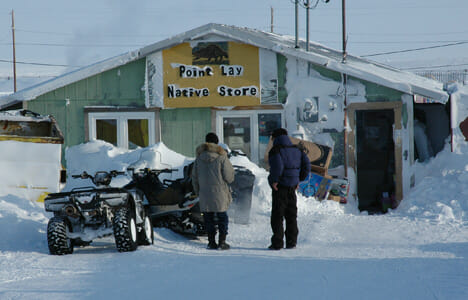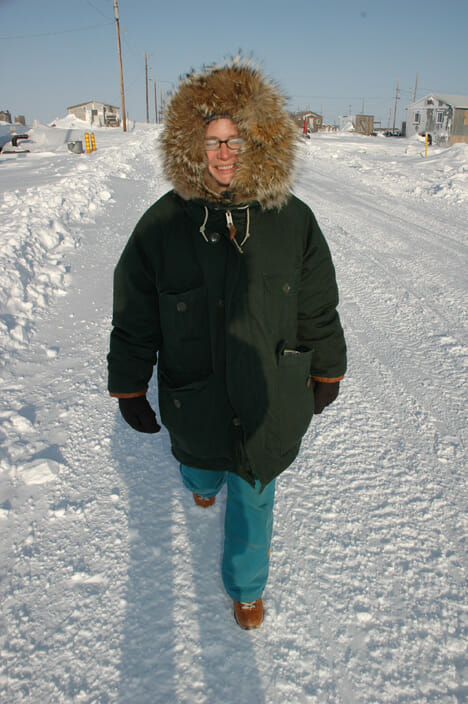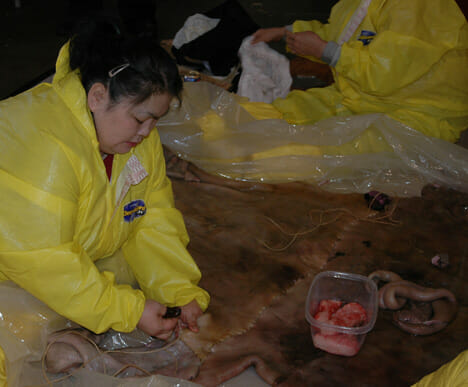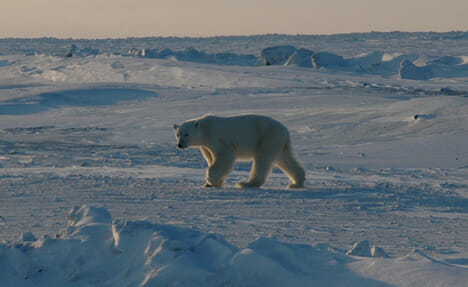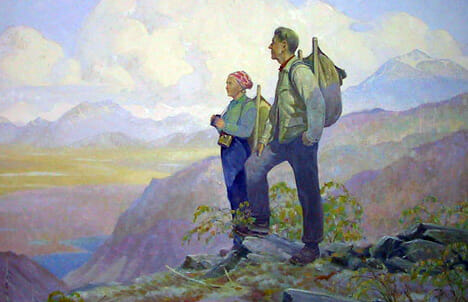We’re off to the cold North for the month of March–Brrrrrr! The temps dipped to -37F and we flew 13 separate flights from our home in Petersburg to Juneau, Anchorage, Fairbanks, Barrow, Point Lay (left on this map), Barrow, Nuiqsut, Deadhorse, Barter Island (Kaktovik–right on the map), Fairbanks, Seattle, Ketchikan and finally home. Mt. Redoubt threw a wrench in our flight plans forcing us all the way to Seattle before we could return north. Remember Barrow from or 2006 blog?…
We work for three days at Samuel Simmonds Hospital learning the ropes, then head west to Point Lay; possibly the windiest place on earth (after Antarctica). It’s nearly the equinox so the sun is rising and setting at opposite horizons and at this latitude, 71 North, it rises sideways. We choose a Cessna Caravan–the aerial equivalent of a Toyota Landcruiser. Point Lay is just a smudge on the horizon when we approach. Fortunately, the wind has subsided and we can see the town:
Point Lay is just a smudge on the horizon when we approach. Fortunately, the wind has subsided and we can see the town: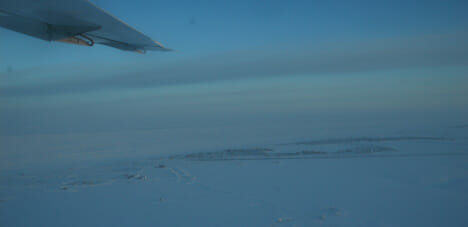
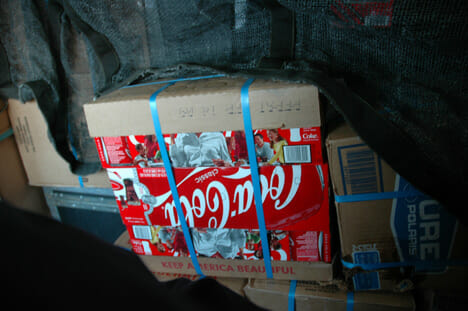
Sitting next to us on the plane is the preferred Beverage of the North–and our job security…. But this is just half the picture–one needs solid food too and here is the main diet: This is one of several candy stores–usually run by village elders or perhaps the schools themselves. On our clinic walls are horrible pictures of meth-mouths but frankly, I do not see any difference between meth-mouth and candy-mouth. Drugs, whether alcohol, meth or candy, are a huge problem here in Alaska. There was one suicide during our North Slope stay and one fatal drug overdose in our town while we were gone.
This is one of several candy stores–usually run by village elders or perhaps the schools themselves. On our clinic walls are horrible pictures of meth-mouths but frankly, I do not see any difference between meth-mouth and candy-mouth. Drugs, whether alcohol, meth or candy, are a huge problem here in Alaska. There was one suicide during our North Slope stay and one fatal drug overdose in our town while we were gone.
Here’s the sunrise–the sun enters the picture at the closest telephone pole–then moves to the right. On March 20, everyone on the planet gets the same amount of sunlight. And this is what town looks like….about 9 months a year!
The population of Point Lay at this time of year is about 120 and typically half the population is 15 years old or younger. Much of the culture of the Eskimo people is fading fast with the language nearly gone. Yet, North Slopers are politically correct with Inupiat Braille signage in our clinic: Forget about the Braille; I couldn’t find anyone who could pronounce it. Martina sets up our clinic.
Forget about the Braille; I couldn’t find anyone who could pronounce it. Martina sets up our clinic.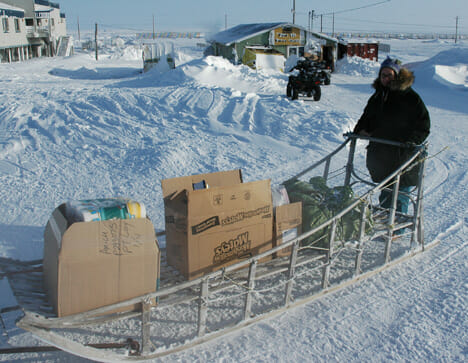 Here is Martina of the North in front of the Native Store. On this sled is a case of Pepsi and the hind quarter of a caribou–it is towed by a snow machine. During our “Did Not Keep Appointments” or “DNKAs” we walk around town and take pictures:
Here is Martina of the North in front of the Native Store. On this sled is a case of Pepsi and the hind quarter of a caribou–it is towed by a snow machine. During our “Did Not Keep Appointments” or “DNKAs” we walk around town and take pictures: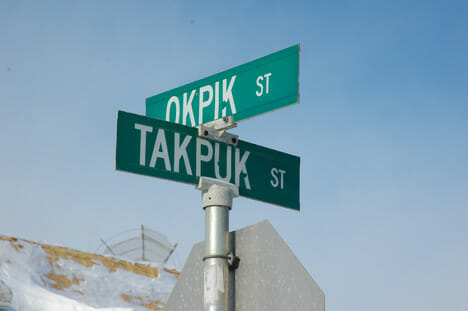 Hanging out at the corner of Okpik and Takpuk….
Hanging out at the corner of Okpik and Takpuk….
It’s 25 F below zero! Don’t forget to roll up your windows….
Don’t forget to roll up your windows…. Right after our arrival, the wind picks up and no one goes outside–it’s blowing about 60-80 mph at temps -30F which adds up to a huge wind-chill. We are staying in the firehouse and have to walk across the street to the clinic. Due to the weather, no one shows up Sunday for our clinic; when the Eskimos stay inside, you know the weather’s bad.
Right after our arrival, the wind picks up and no one goes outside–it’s blowing about 60-80 mph at temps -30F which adds up to a huge wind-chill. We are staying in the firehouse and have to walk across the street to the clinic. Due to the weather, no one shows up Sunday for our clinic; when the Eskimos stay inside, you know the weather’s bad.
Back in Barrow, we team up with a dog musher, Geoff Carroll, who runs a very smart team and even took it to the North Pole in 1986 with the Steger Expedition. They were the first to make it to the pole without airdrops or resupply.
I can’t resist temptation and take a ride out on the Chuckchi sea ice. Commands to dogs are “Kiita” which is Inupiat for Go, ‘Haw’ is Left, ‘Gee’ is Right and Whoa to stop–but the steel brake helps that command as dogs will take off with an empty sled. Another weekend diversion is visiting the Inupiut Heritage Center which is a must if you find yourself in Barrow.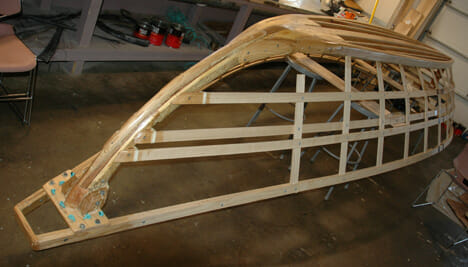 These are the traditional whale hunting boats although today they’re made with better materials than driftwood and sinew.
These are the traditional whale hunting boats although today they’re made with better materials than driftwood and sinew.
Here’s the seal skin being scrapped, cut and sewn together…..now this is traditional, especially the smell. To make the skin waterproof, it is rolled up in fat, then buried in the ground to ferment for several months. Believe me, you will not forget this smell and it won’t forget you either.
Check out this stitchwork–these seams are sewn with braided caribou sinew which is strong and water tight.
Our last village is Kaktovik where we work 10 days straight. Kaktovik is located on Barter Island on the Beaufort Sea about 250 miles east of Barrow and only 90 miles from Canada. The Brooks Range is only 60 miles south. This is ANWR and everyone here has an opinion of it’s fate. About half the people in this town want oil drilling to occur and half don’t, which is the typical Alaska split on just about every subject.
Note the sea ice that has separated from the shoreline and blown offshore creating miles of open water. The ice has also thinned making tough going for Polar Bears. During our stay, a polar bear wanders into town–these are hungry bears and are attracted to human habitation much like the Yellowstone bears were drawn to garbage dumps. Also, Brown Bears are now competing with Polar Bears in this area. These are beautiful animals but people still kill them for rugs….
….which is exactly the fate of this bear four hours after we take this picture. It was shot from the back porch of a house in Kaktovik at 10:30pm and skinned for a rug. We would encourage people to write their representatives in congress to protect these animals from all humans. And if you believe in Karma, check out this article on CNN’s website posted 10 days later.
In Kaktovik, we meet Robert and Jane Thompson who run Kaktovik Arctic Adventues. They take people on guided trips into the Brooks Range through ANWR–and do it right. They have an 11 day float trip from the Brooks range to the Beaufort Sea.
The title of this blog Two in the Far North is also the title of a book by Margaret E. Murie. Here’s a photo of Mardy and Olaus in the Brooks Range painted by ‘Rusty’ Heurlin that hangs in the University of Fairbanks Museum:
No two people deserve more credit for protecting ANWR. Mardy and her husband Olaus, skied up the Porcupine and Sheenjek Rivers in the 1920s and did the early field biology of that area. Mardy was the first woman to graduate from the University of Alaska. She and Olaus both received the Audubon Medal; she from President Jimmy Carter and he from John Kennedy. I met Mardy when rangering at Grand Teton National Park in the early 1970s and stayed in touch with her until her death in 2003 at 101.
Visit Martina’s blog by clicking here.

